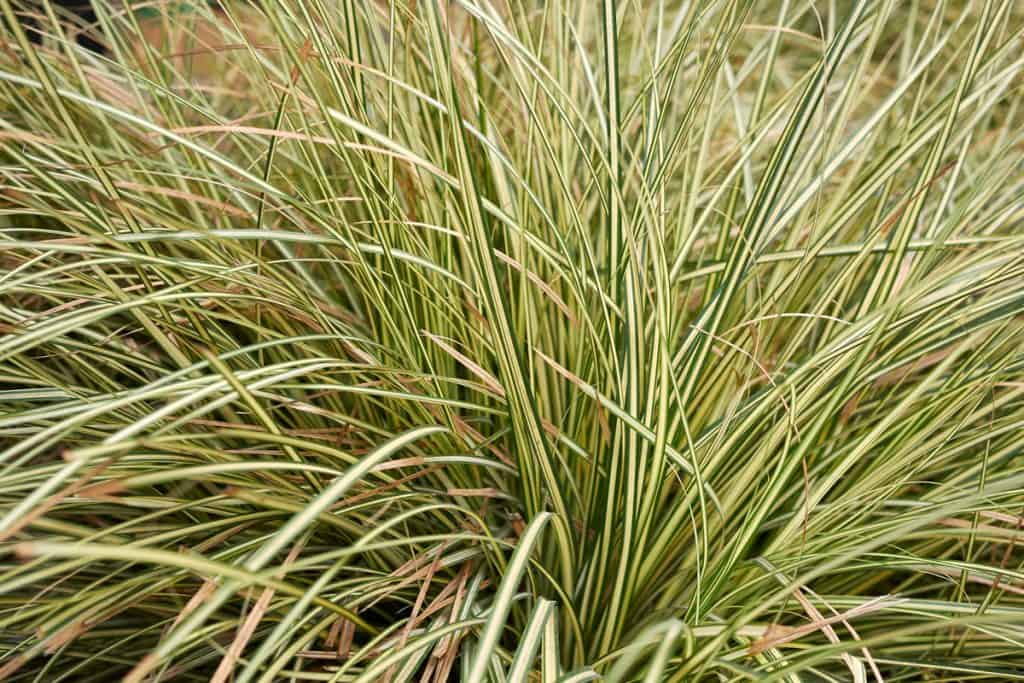Ornamental grasses are a great way to add greenery and interest to the shadier corners of your landscaping. Below is a list of the best ornamental grasses to help you choose the right one for your garden.
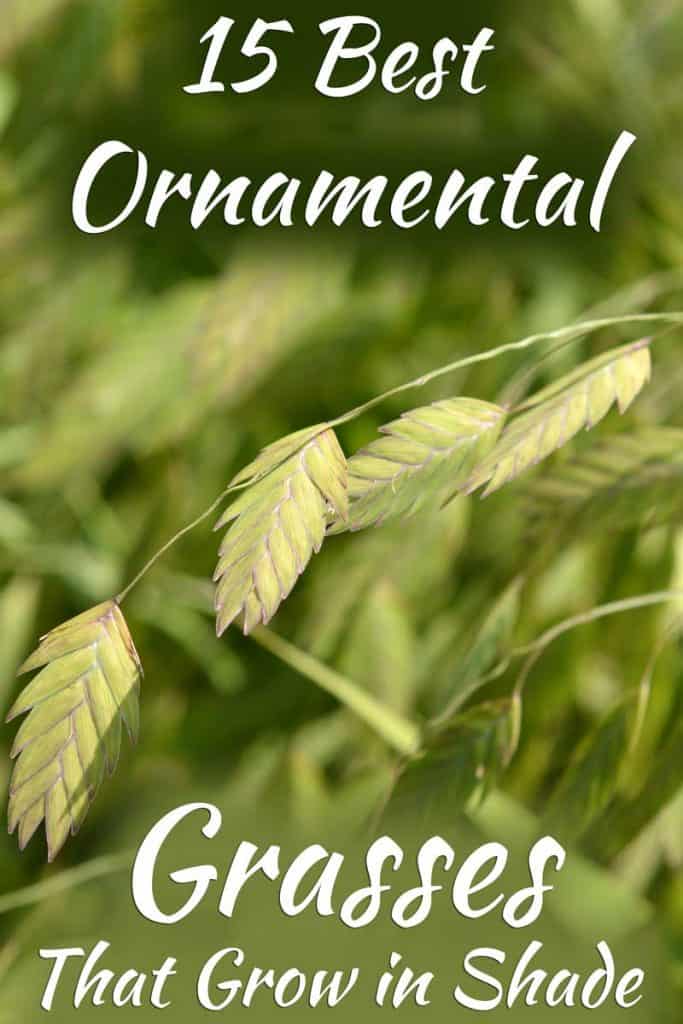
1. Tufted Hair Grass
Tufted hair grass, otherwise known as deschampia cespitosa or tussock grass, is a popular choice of ornamental grass. It relatively small mounds are only around 16inche wide, grow tall thin green blades of grass that may be in-rolled.
The primary reason this grass is so popular is due to the flowers that bloom in the summer. In the summer, the plant shoots up three feet tall billowy plume of wispy blooms in varying colors. These blooms turn gold as the summer progresses and when dried look lovely in a flower arrangement.
Growing Tips and Care
Tufted hair grass is easy to grow. Just plant in partial to full shade in moist, fertile soil. Be careful not to plant in too deep of shade, as the flowers do not do as well the less sunlight that there is. It really requires little care other than cutting down the old shoots in the winter before new growth sprouts to keep things tidy.
Tufted Hair Grass
The bright green grass crowned with feathery white flowers is the perfect edging for a stone walkway through a natural-style garden.
2. Japanese Forest Grass
Japanese Forest Grass, or Hakonechloa macra, and commonly referred to as Hakone grass, has variegated bright green leaves that are more vibrant in the sun but is equally lovely in the shade. The leaves change to a coppery-orange color in the fall, adding beauty to your autumn landscape. It is a perennial in zone 5-9, where you will be able to enjoy its beautiful color for years.
Growing Tips and Care
This grass grows in dense mounds that are roughly 18 inches tall and wide and is a great way to fill in space and brighten darker corners of your yard. It prefers part to full shade. Plant in well-drained, humus-rich soil, and keep watered.
It is very pest resistant and requires very little maintenance other than cutting it down after it dies out in the winter.
Japanese Forest Grass
This grass is perfect for tucking around the base of trees or filling in spaces in shady flower beds. Here it is planted in an old wheelbarrow to excellent effect. You can almost hear the swish of the leaves in the breeze!
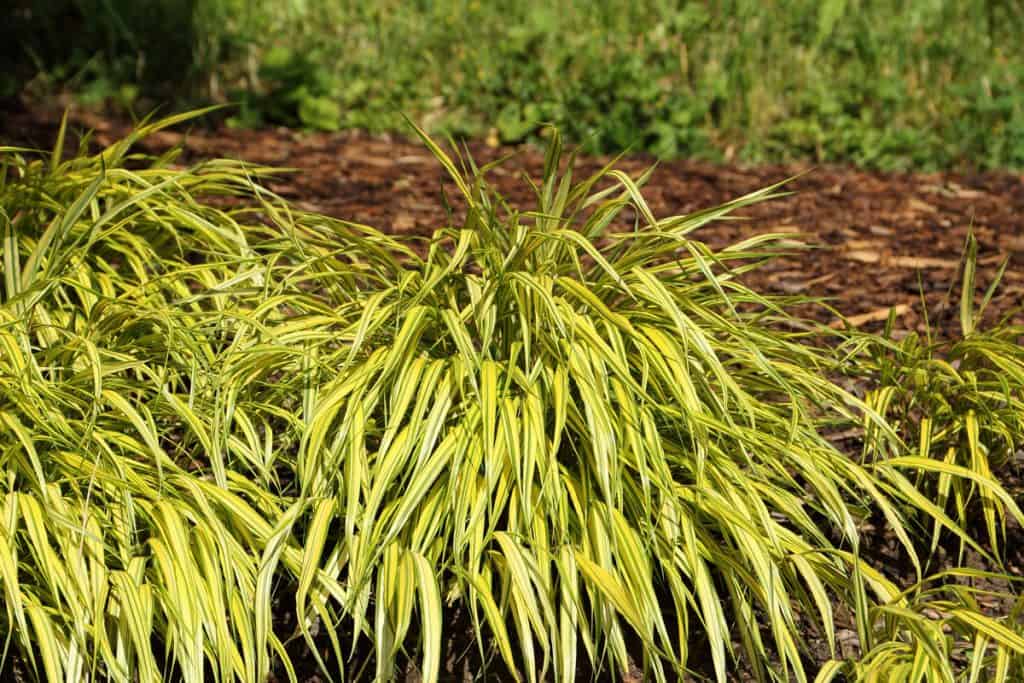
Add this vibrant grass to your landscape with at live plant from New Life Nursery and Garden. The plant is shipped in a gallon pot and is ready to transplant upon reciept.
All Gold Japanese Forest Grass
3. Northern Sea Oats
Chasmanthium latifolium, also known as woodoat, inland seas oats, northern sea oats, and river oats, is a grass that is native to the southern and eastern parts of the United States and northern Mexico. It has long, dark green leaves with a pointy end. It grows flowers that look like the heads of wheat which turn a bronzy color in the fall. Sea Oats grow in loosely tufted clumps and is perfectly happy in either sun or shade, and can get 3-5 feet tall and wide
Growing Tips and Care
Northern Sea Grass is hardy through Zone 5 and prefers dry or well-drained soil that is rich with natural compost. It requires very little care and is naturally pest resistant.
Use caution when choosing your location, as this grass is very tall, and can spread quickly through the spreading of the seeds. If can become invasive if not kept in check. Keep the seed heads cut back to minimize spreading.
Northern Sea Oats
The dried flowers from this plant are the real showstopper. The flat, flag-shaped fronds are often used in flower arrangements and autumn decor.
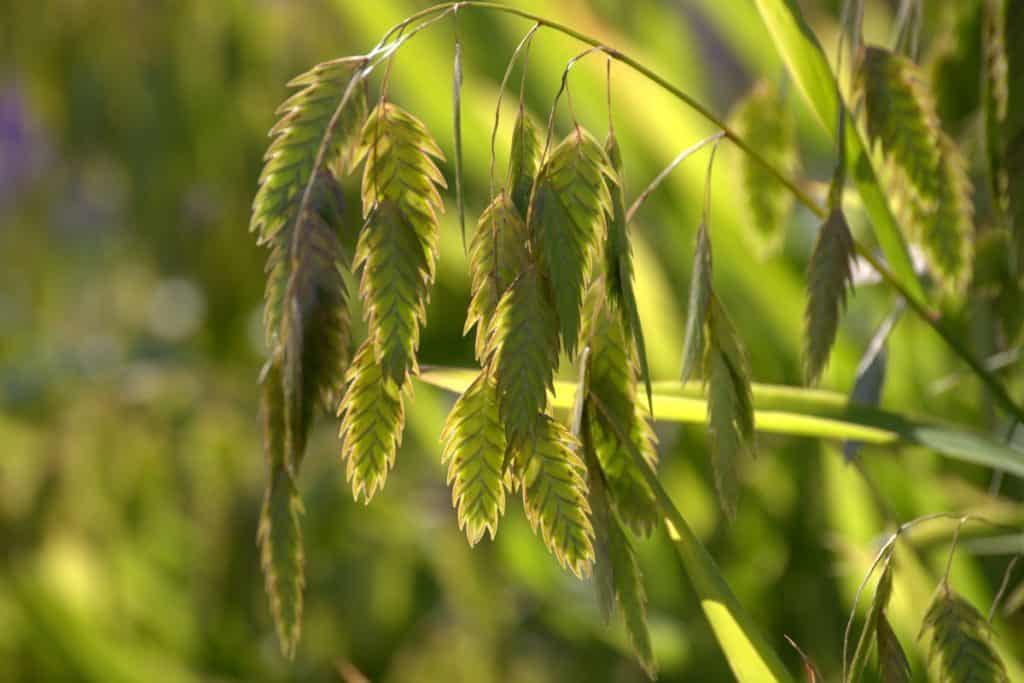
Get your northern sea oats started in your garden with a bare root plant from Twin Oaks Farms-Seeds. This plant is easy to start from seed, almost too easy due. Maintain control over where this might grass grows by starting with a plant instead of a pocketful of seeds.
4. Sedge Grass
For a native grass look, there is the humble sedge grass, in the genus Carex. These are not actually a grass, but an evergreen with a grass-like appearance. They do better in the shade than in the sun, so are a perfect choice for your woodland areas. Most sedges grow in tufts of thin green, blue-green, yellow or copper blades that vary in size depending on the type of sedge. There are over 100 species of sedge grass.
Growing Tips and Care
Sedge Grass is a free-spirited plant and thrives with minimal efforts. They need very little fertilizer and can withstand rough handling. Water once a week until well established, and thereafter as needed.
Carefree Landscaping
In this simple yet effective landscaping, mounds of sedge grass are used in combination with stone and agave to create a low maintenance Southwestern-style garden.
Orange Sedge Grass is unique in its burnt orange color. The older the plant, the bolder the color.
Everillo, from Perrenial Farm Marketplace, has stunning bright yellow-green foliage that will brighten the darkest corner of your landscaping.
5. Creeping Lilyturf
Also known as Liriope spicata, creeping liriope, lilyturf, or monkey grass, creeping lilyturf has deep green leaves and spiky lavender blooms that turn to black berries in the fall. It is frequently used as a groundcover as the plants grow out about 18 inches wide. They thrive in Zones 5-11 when planted in partial sun.
Growing Tips and Care
Plant Creeping lilyturf in well-drained soil in full sun to part shade. It can tolerate a range of soil types, as long as it has good drainage. It is pretty resistant to pests and disease, although it can be susceptible to root rot if it does not have good drainage.
Pretty in Purple
It can be challenging to find flowering plants that thrive in shady places. The search is over with creeping lilyturf, as the pretty purple spikes will bring a pop of color to your shade garden.
6. Greater Wood Rush
Greater Woodrush, or Luzulu sylvatica, is an amazing plant if you want a mass planting that will cover your landscape like a carpet. It is an excellent groundcover, spreading up to 24 inches. It grows in dense clumps and has bright green foliage. It does bloom, but the brown blooms are barely noticeable. It is a showy perennial that will do well in zones 4-9.
Growing Tips and Care
Greater Woodrush is low maintenance and prefers part to full shade areas. It does not like to be in the hot sun. It prefers fertile well-drained soil but will tolerate poorer soil.
Grow Your Own
Get a headstart on your carpet of greenery with these seeds from SVI. This packet of 25 seeds is easy to grow and make it much more cost effective to install these plant en mass.
7. Japanese Sweet Flag
Acorus gramineus, or Sweet Flag, is a pretty wetland type grass that can resemble cattails. It is called sweet flag because it emits a sweet smell when crushed. It grows up to 12 inches tall with spiky bright yellow-green leaves. It can spread slowly, to 24 inches wide. It grows best in Zone 5-9.
Growing Tips and Care
Sweet Flag does best in partial shade, in average soil with plenty of soil. It thrives in boggy conditions, like along a creek bank or pond, so be sure to keep it well watered.
Great for Water Features
Sweet Flag loves water, which makes it perfect for edging ponds or other water features.
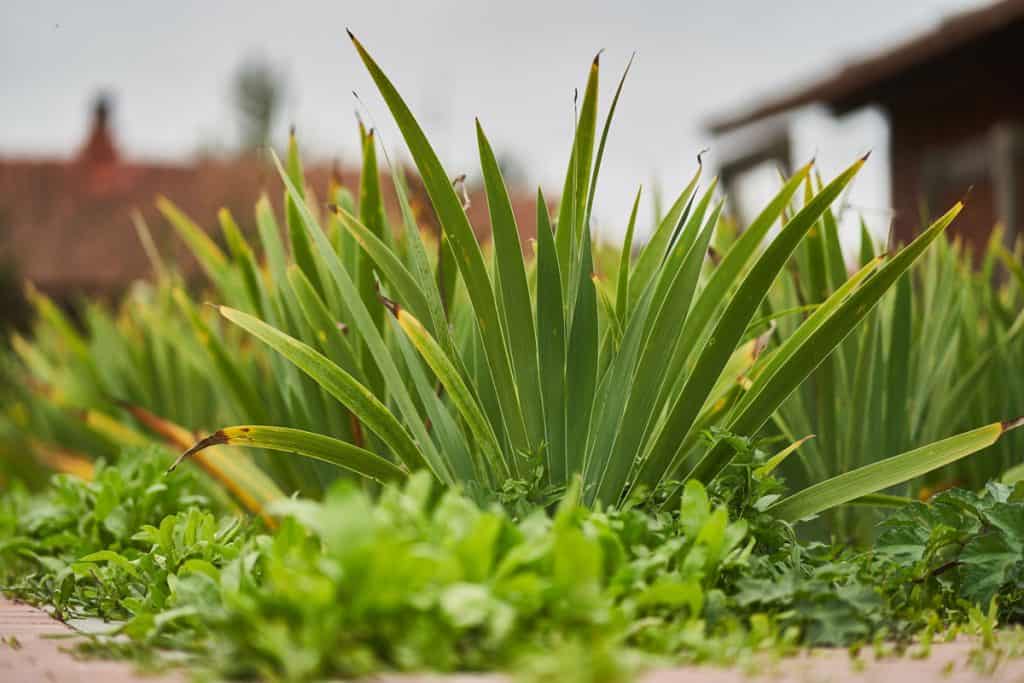
Looking to line the edge of your pond with Sweet Flag? Classy Groundcovers's has 25 live plants to get you off to a great start!
8. Korean Feathered Reed Grass
Calamagragrostis brachticha, more commonly referred to as Korean Feathered Reed Grass, is a very pretty ornamental grass that will add visual interest to your garden. This herbaceous evergreen can grow 2-3 feet tall and wide, making for an impressive show. It has tall feathery pink flowers that are very showy and would be great for flower arrangements or other decorating. It grows best in zone 4-9.
Growing Tips and Care
Korean Feathered Reed Grass does best in partial or dappled shade, so it would be a good addition as an underplanting to ornamental trees. It doe well in average oil, but must be kept watered. Cut the plants back in late winter to encourage new growth.
Perfect Backdrop
This plant grows so tall, it is a perfect choice for the back of the flower bed. Here it has been used to line the back of the garden, it flowing plumes standing majestically over the other plants. It also can be used to provide a bit of privacy, screening the view of the yard from those on the wrong side of the landscaping.
Add some to your garden with this live plant from Perennial Farm Marketplace.
9. Umbrella Grass
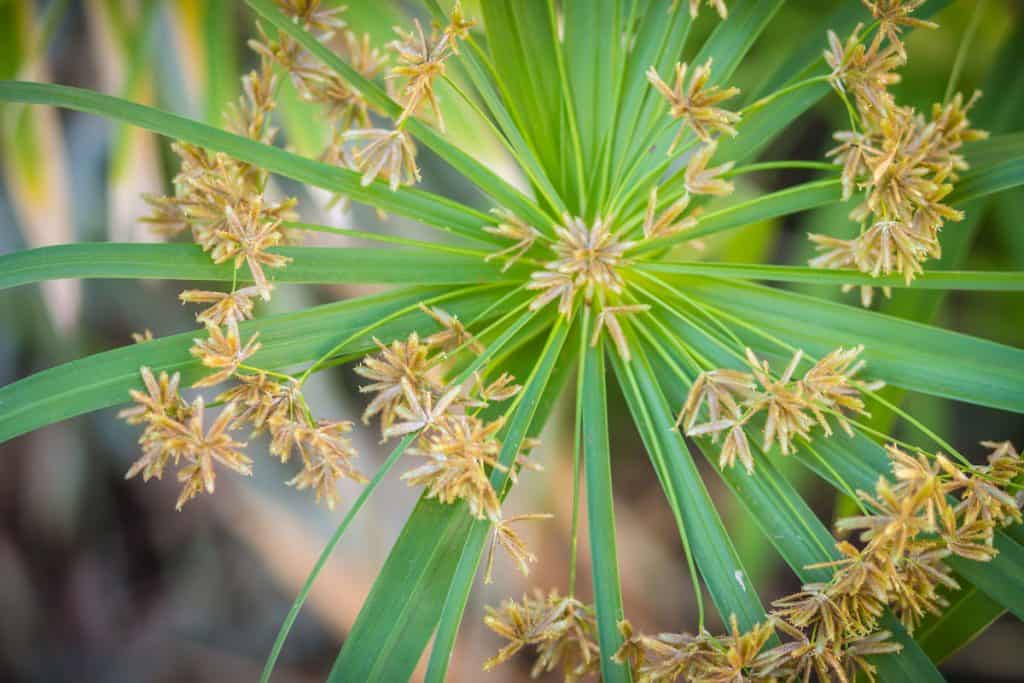
Cyperus involucratus has a lot of names, including umbrella grass, umbrella papyrus, umbrella palm, and umbrella sedge. It gets its name from the unique shape of the leaves. Each shoot is topped with a front that is shaped like the inside of an umbrella. It grows in clumps that get about 20 inches wide.
This plant does best in Zones 9-11, due to its tropical nature. In cooler climates, it will be an annual. It loves water and will add a tropical flair in pots by the poolside or planted around a pond or waterfall feature. It also makes an excellent houseplant due to its tolerant nature.
Growing Tips and Care
Umbrella grass is very easy to grow as long as it doesn't get too cold (below 50 degrees) and has plenty of water. You can fertilize it every couple of weeks with a weak fertilizer if you like but it will do fine without it. If the leave starts to turn brown, it means that it is not getting enough water, so be sure to keep it saturated.
It can also become infested with spider mites, especially if it gets too dry.
Great for Indoors
Use the umbella plant in a big pot to decorate your poolside in the summer, then bring it in for the winter. It is an easy-care houseplant and will add beauty to whatever room you put it in.
Add umbrella grass to your landscape with a plant (or 3) from 9EzTropical. Get a 3-inch pot that contains 3 live plants that are ready to transplant to a beautiful Asian inspired planter, or tucked into the boggy soil around your koi pond.
10. Needlegrass
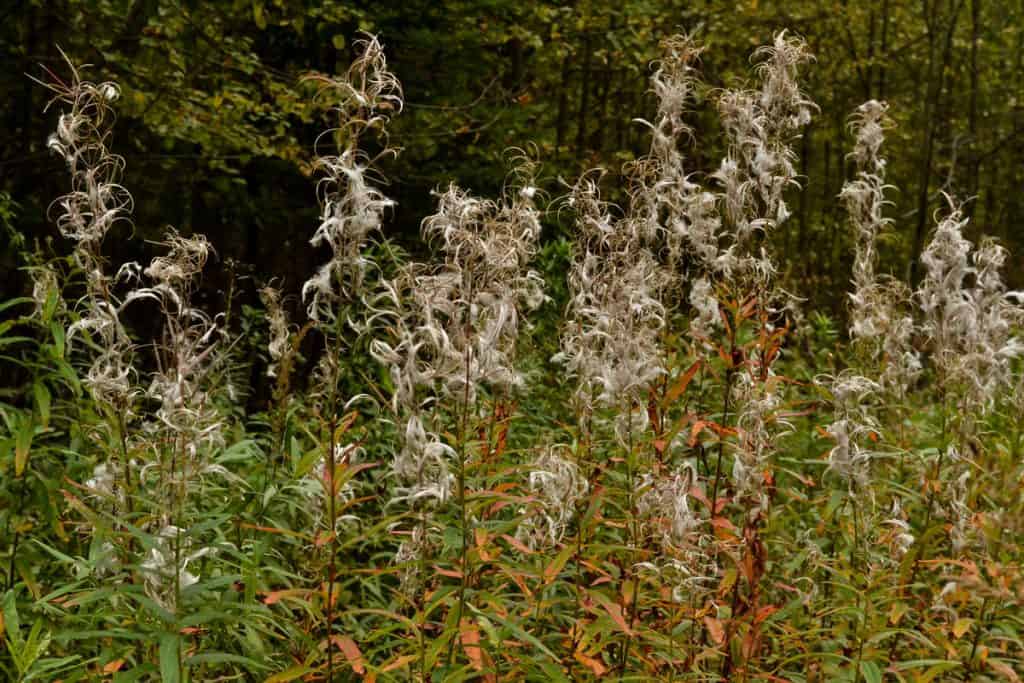
Needlegrass, also known as feather grass, and spear grass, is part of the genus Nasella. The name needle grass comes from the long- thin bristly hair leaves that grow from a large clump. Some types of needle grass are stiffer than others and can actually puncture the faces of feeding animals. It is beautiful as an ornamental grass due to its pretty seed heads and arching leaves.
Needlegrass is native to North America and Purple Needle Grass is used in California as a method to control erosion. It is can grow up to 5 feet high and does well in zones 5-10. There are several different types of needlegrass, including Purple needlegrass, Texas needlegrass, Green needle grass, Thurber's needlegrass.
Growing Tips and Care
Needlegrass is a native plant, so once established, it usually does not require much care. It can grow in poor soil. Keep it watered the first year after planting but after that, it should be fine on its own as it is drought resistant. It is a great addition to any area that gets partial sun and just doesn't seem to want to grow anything else.
Thin and Strong
This grass can be an interesting addition to your landscape with its tall thin leaves and graceful arching shape.
You can find Purple needlegrass live plants at Annies Annuals and Perennials.
11. Maiden Grass
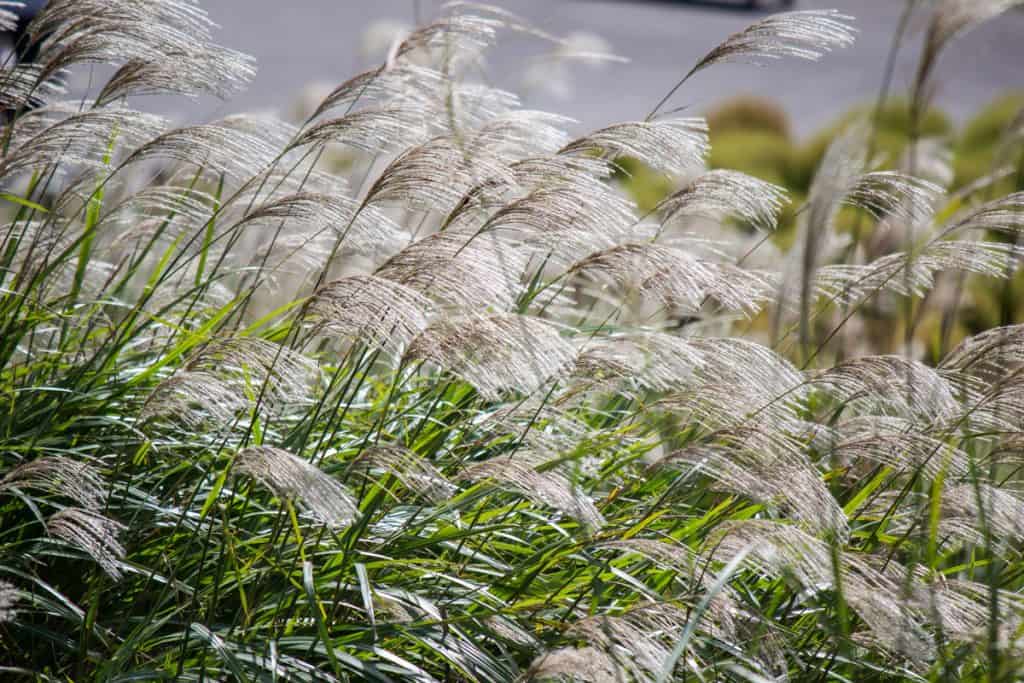
Miscanthus sinensis, or Maiden Grass, is a stunningly graceful ornamental grass with long, fine blades that are silver-green in the spring and summer, and change to a bronze-like color in the fall.
It is a large plant, growing 6 to 8 feet tall and 3 to 5 feet wide. It does well in zones 4-9.
Growing Tips and Care
Maiden Grass can tolerate partial shade but needs some sun, so it is not suitable for deeply shady areas. Plant it in average, well-drained soil and keep it watered the first year so roots can get established. Cut them back in late winter to encourage new growth.
Graceful and Delicate
Maiden grass develops graceful seed heads and the whole plant will sway in the breeze. Add this gorgeous plant somewhere you can just sit an listen to the gentle breeze rustle in the leaves.
The Garden Greenhouse has these luscious plants available. so u can add them to your landscaping.
12. Junegrass
Koeleria cristata, mountain junegrass, and junegrass are all names for this delightful plant. This is a native prairie plant that grows to about 2 feet tall. It has long thin green blades and produces large, fluffy silver seed head in the summer that turns to gold by early fall.
Shorter than some of the other grasses, it grows to around 2 feet tall. It is hardy in zones 3-9 and is a cool season grass which means most of its new growth occurs in the spring.
Growing Tips and Care
While this plant prefers at least 6 hours of sun a day, it can tolerate some shade, especially in the hot summer afternoons. Plant it in dry, sandy soil. It is perfect for areas with poor soil where other plants don't want to grow. It is very drought resistant and does not need fertilizer. Do not cut back until very early spring.
It is susceptible to some pests, like the striped flea beetle. If the leaves start to wilt, that could be a sign of infestation and you will want to treat with an organic pesticide.
Great for Autumn Decor
The pretty seed heads turn a lovely shade of gold in early fall, which looks great in autumn arrangements or wreaths.
13. Hair Grass
Hair grass, or deschampria, is also known as tussock grass. It is a perennial grass that grows in mounds from 2 to 4 feet tall and wide. It gets hairy seed heads in the summer that vary in color from green to gold.
Growing Tips and Care
Hair grass is very low maintenance and will thrive in almost any soil type. They prefer light to medium shade, so they would be great to add to some of the shadier corners of your landscaping. Water deeply whenever the soil gets completely dried out.
Remove dead blade of grass in the spring by combing through with our fingers. The old growth will break off, allowing the air and light to get to the interior of the plant and promote new growth.
Easy Greenery
The spiky green grass is a pretty and interesting addition for shady beds or would look wonderful under ornamental trees.
Direct Sow these Blue Hairgrass seeds from Javagado Land. Cover with a thin layer of vermiculite, lightly water, and you should see sprouts within 10 days.
14. Bottle Brush Grass
Bottle Brush Grass or elymus hystrix is a grass that is native to the U.S. and Canada. The plants grow about 12 inches in height and produce spiky blooms that are reminiscent of the brushes used to clean baby bottles. The blooms appear in mid to late summer and gradually change from green to brown as summer progresses.
Growing Tips and Care
This plat is very easy to grow and care for, as it is tolerant of a variety of conditions. It needs average, well-drained soil and sun to part shade. It is perfect for planting in dappled woodland or natural type landscaping. It is not susceptible to any specific pests or diseases.
Unique Appearance
The bloom from which Bottle Brush Grass gets is name is very unique its appearance and so will make a statement in your landscaping.
Seeds from Bottle Brush Grass are available from The Vermont Wildflower Farm.
Mix the seed into some sand, to dilute the seed mixture, then apply to the prepared soil. Gently press into the soil. gently water, and you will soon see sprouts.
15. Ribbon Grass
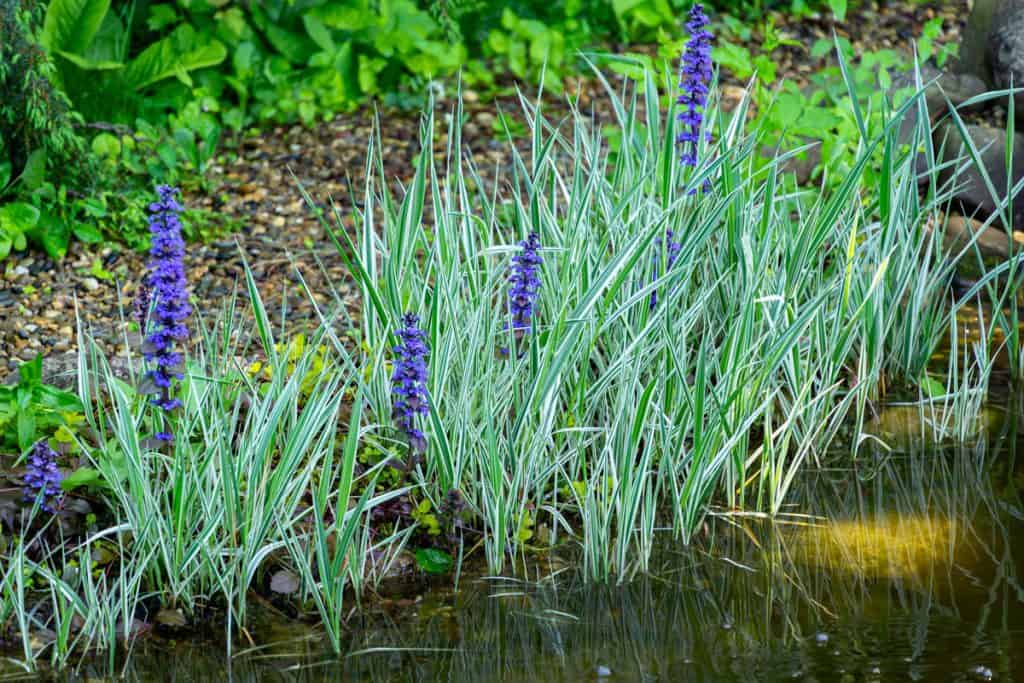
Phalaris arundinacea, or Ribbon Grass is a quick spreading ground cover with a pretty long blade of pale green striped with a darker green center. It grows to about 2 feet tall. It is hardy in zones 2 to 9. Be careful where you plant this though as it can become invasive if left unchecked. It is best used on hillsides or areas where nothing else seems to want to grow and you don't have to worry about containing it. It is less invasive in the shade, however, so you can feel more comfortable using it without fear that it will take over everything.
Growing Tips and Care
This plant grows voraciously in sunny areas and is highly tolerant of most conditions. Plant in the shade, in average, moist soil. Mulch around the base of the plant in cooler climates to protect the roots from freezing. It has a high resistance to pests and disease, so once it is established, it needs very little effort.
Silver and Green
Variegated types are the most commonly found cultivars of this plant. 'Picta' has creamy white and pale green striped leaves, while 'Feesy' is striped in mostly white and green.



